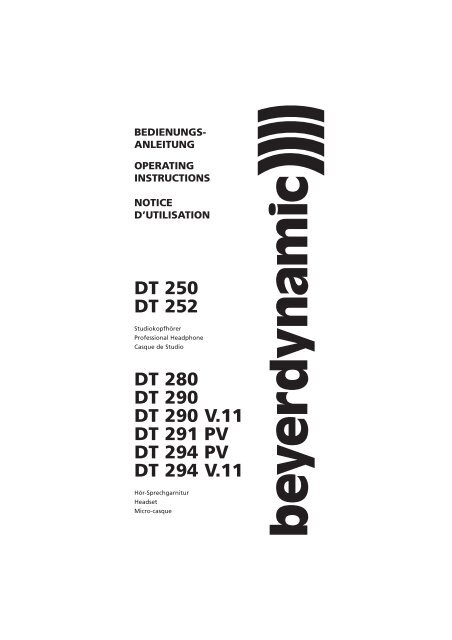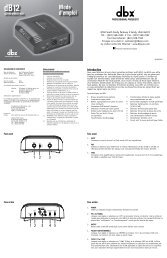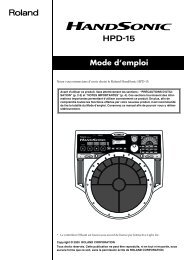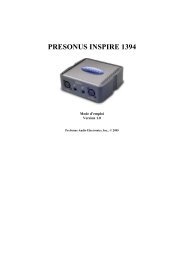DT 250 DT 252 DT 280 DT 290 DT 290 V.11 DT 291 ... - Univers-Sons
DT 250 DT 252 DT 280 DT 290 DT 290 V.11 DT 291 ... - Univers-Sons
DT 250 DT 252 DT 280 DT 290 DT 290 V.11 DT 291 ... - Univers-Sons
Create successful ePaper yourself
Turn your PDF publications into a flip-book with our unique Google optimized e-Paper software.
BEDIENUNGS-<br />
ANLEITUNG<br />
OPERATING<br />
INSTRUCTIONS<br />
NOTICE<br />
D’UTILISATION<br />
<strong>DT</strong> <strong>250</strong><br />
<strong>DT</strong> <strong>252</strong><br />
Studiokopfhörer<br />
Professional Headphone<br />
Casque de Studio<br />
<strong>DT</strong> <strong>280</strong><br />
<strong>DT</strong> <strong>290</strong><br />
<strong>DT</strong> <strong>290</strong> <strong>V.11</strong><br />
<strong>DT</strong> <strong>291</strong> PV<br />
<strong>DT</strong> 294 PV<br />
<strong>DT</strong> 294 <strong>V.11</strong><br />
Hör-Sprechgarnitur<br />
Headset<br />
Micro-casque
INHALT / CONTENTS / SOMMAIRE<br />
BEDIENUNGSANLEITUNG <strong>DT</strong> 200-SERIE<br />
Charakteristik . . . . . . . . . . . . . . . . . . . . . . Seite 4<br />
Anschluss . . . . . . . . . . . . . . . . . . . . . . . . . . Seite 5<br />
Anwendung. . . . . . . . . . . . . . . . . . . . . . . . Seite 6<br />
Pflege . . . . . . . . . . . . . . . . . . . . . . . . . . . . Seite 7<br />
Ausführungen . . . . . . . . . . . . . . . . . . . . . . Seite 8<br />
Ersatzteile . . . . . . . . . . . . . . . . . . . . . . . . . Seite 9<br />
Optionales Zubehör. . . . . . . . . . . . . . . . . . Seite 9<br />
Technische Daten. . . . . . . . . . . . . . . . . . . . Seite 11<br />
OPERATING INSTRUCTIONS <strong>DT</strong> 200-SERIES<br />
Design Features . . . . . . . . . . . . . . . . . . . . . Page 18<br />
Connection . . . . . . . . . . . . . . . . . . . . . . . . Page 19<br />
Operation . . . . . . . . . . . . . . . . . . . . . . . . . Page 20<br />
Maintenance . . . . . . . . . . . . . . . . . . . . . . . Page 21<br />
Models. . . . . . . . . . . . . . . . . . . . . . . . . . . . Page 22<br />
Spares . . . . . . . . . . . . . . . . . . . . . . . . . . . . Page 23<br />
Optional Accessories . . . . . . . . . . . . . . . . . Page 23<br />
Technical Specifications . . . . . . . . . . . . . . . Page 25<br />
NOTICE D’UTILISATION SERIES <strong>DT</strong> 200<br />
Description . . . . . . . . . . . . . . . . . . . . . . . . Page 32<br />
Branchements . . . . . . . . . . . . . . . . . . . . . . Page 33<br />
Utilisation . . . . . . . . . . . . . . . . . . . . . . . . . Page 34<br />
Entretien . . . . . . . . . . . . . . . . . . . . . . . . . . Page 35<br />
Modèles . . . . . . . . . . . . . . . . . . . . . . . . . . . Page 36<br />
Pièces de rechange . . . . . . . . . . . . . . . . . . Page 37<br />
Accessoires en option . . . . . . . . . . . . . . . . Page 37<br />
Spécifications techniques . . . . . . . . . . . . . Page 39<br />
deutsch<br />
english<br />
français<br />
3
4<br />
BEDIENUNGSANLEITUNG<br />
<strong>DT</strong> <strong>250</strong> / <strong>DT</strong> <strong>252</strong> / <strong>DT</strong> <strong>280</strong> / <strong>DT</strong> <strong>290</strong> / <strong>DT</strong> <strong>290</strong> <strong>V.11</strong> /<br />
<strong>DT</strong> <strong>291</strong> PV / <strong>DT</strong> 294 PV / <strong>DT</strong> 294 <strong>V.11</strong><br />
Sie haben sich für den Studiohörer <strong>DT</strong> <strong>250</strong> / <strong>DT</strong> <strong>252</strong> bzw.<br />
für die Hör-Sprechgarnitur <strong>DT</strong> <strong>280</strong> / <strong>DT</strong> <strong>290</strong> / <strong>DT</strong> <strong>290</strong> <strong>V.11</strong> /<br />
<strong>DT</strong> <strong>291</strong> PV / <strong>DT</strong> 294 PV / <strong>DT</strong> 294 <strong>V.11</strong> von beyerdynamic entschieden.<br />
Wir danken für Ihr Vertrauen. Äußerste Präzision bei der<br />
Fertigung und eine strenge Qualitätskontrolle garantieren die<br />
Zuverlässigkeit und den hohen Komfort, die Sie von beyerdynamic-<br />
Produkten erwarten dürfen.<br />
Charakteristik<br />
<strong>DT</strong> <strong>250</strong> / <strong>DT</strong> <strong>252</strong><br />
Der geschlossene Studiohörer <strong>DT</strong> <strong>250</strong> / <strong>DT</strong> <strong>252</strong> bietet<br />
eine gute Isolation von Außengeräuschen. Er eignet sich daher<br />
für den Einsatz als Kontrollhörer in Tonstudios, bei Rundfunk<br />
und Fernsehen. Auswechselbare, weiche Ohr- und Kopfpolster<br />
bieten einen hohen Langzeit-Tragekomfort. Das leistungsstarke<br />
Neodym-Magnetsystem sorgt für eine hohe Wiedergabepräzision<br />
und ein ausgewogenes, weiträumiges Klangbild. Die Standardimpedanz<br />
beträgt 80 Ω. Für höchste Wiedergabetreue ist<br />
ein besonders aufwendig konstruiertes System mit <strong>250</strong> Ω lieferbar.<br />
Die Anschlusskabel zu den Hörmuscheln sind geschützt<br />
im Kopfbügel geführt. Das Hauptanschlusskabel ist steckbar<br />
und wird einseitig geführt.<br />
<strong>DT</strong> <strong>280</strong> / <strong>DT</strong> <strong>290</strong> / <strong>DT</strong> <strong>290</strong> <strong>V.11</strong><br />
Wie <strong>DT</strong> <strong>250</strong>, jedoch mit dem dynamischen Mikrofon<br />
DM <strong>290</strong> in Hypernierencharakteristik. Die Hör-Sprechgarnitur<br />
<strong>DT</strong> <strong>280</strong> / <strong>DT</strong> <strong>290</strong> / <strong>DT</strong> <strong>290</strong> <strong>V.11</strong> können Sie für Reportage- und<br />
Kommandozwecke bei Rundfunk und Fernsehen einsetzen.<br />
<strong>DT</strong> <strong>291</strong> PV / <strong>DT</strong> 294 PV / <strong>DT</strong> 294 <strong>V.11</strong><br />
Wie <strong>DT</strong> <strong>250</strong>, jedoch mit dem Elektret-Kondensator-<br />
Mikrofon EM <strong>291</strong> in Kugelcharakteristik (<strong>DT</strong> <strong>291</strong> PV) und in<br />
Nierencharakteristik (<strong>DT</strong> 294 PV + <strong>DT</strong> 294 <strong>V.11</strong>). Die Hör-<br />
Sprechgarnitur <strong>DT</strong> <strong>291</strong> PV / <strong>DT</strong> 294 PV ist mit einem eingebautem<br />
Vorverstärker für Phantomspeisung ausgerüstet.<br />
<strong>DT</strong> 294 <strong>V.11</strong> besitzt einen eingebauten Mikrofonvorverstärker<br />
für die Tonaderspeisung.
Anschluss<br />
Der Studiohörer <strong>DT</strong> <strong>250</strong> / <strong>DT</strong> <strong>252</strong> bzw. die Hör-Sprechgarnitur<br />
<strong>DT</strong> <strong>280</strong> / <strong>DT</strong> <strong>290</strong> / <strong>DT</strong> <strong>290</strong> <strong>V.11</strong> / <strong>DT</strong> <strong>291</strong> PV /<br />
<strong>DT</strong> 294 PV / <strong>DT</strong> 294 <strong>V.11</strong> werden mit passendem Anschlusskabel<br />
geliefert. Sonderkabel können zusätzlich geordert werden. Bei<br />
den Kabeln mit freien Enden können Sie die gewünschten<br />
Stecker direkt an das Kabel löten (Anschlussbelegung siehe<br />
„Blockschaltbild”). Auf Wunsch werden die benötigten Stecker<br />
auch im Werk montiert.<br />
Schließen Sie den Studiohörer <strong>DT</strong> <strong>250</strong> / <strong>DT</strong> <strong>252</strong> bzw. die Hör-<br />
Sprechgarnitur <strong>DT</strong> <strong>280</strong> / <strong>DT</strong> <strong>290</strong> / <strong>DT</strong> <strong>290</strong> <strong>V.11</strong> / <strong>DT</strong> <strong>291</strong> PV /<br />
<strong>DT</strong> 294 PV / <strong>DT</strong> 294 <strong>V.11</strong> an hochwertige Geräte mit der entsprechenden<br />
Impedanz und Belastbarkeit an.<br />
Bei der Hör-Sprechgarnitur <strong>DT</strong> <strong>280</strong> / <strong>DT</strong> <strong>290</strong> / <strong>DT</strong> <strong>290</strong> <strong>V.11</strong> ist das<br />
Mikrofon symmetrisch herausgeführt. Es kann aber auch an einen<br />
unsymmetrischen Mikrofoneingang angeschlossen werden.<br />
Für symmetrische Mikrofoneingänge mit Phantomspeisung sind<br />
die Hör-Sprechgarnituren <strong>DT</strong> <strong>291</strong> PV bzw. <strong>DT</strong> 294 PV geeignet.<br />
Der Mikrofonpegel beträgt bei Besprechung aus 5 cm Entfernung<br />
13 mV bzw. <strong>250</strong> mV.<br />
Für den Anschluss an Fernsehkameras mit Mikrofoneingang,<br />
welcher für Tonaderspeisung ausgelegt ist, verwenden Sie die<br />
Hör-Sprechgarnitur <strong>DT</strong> <strong>290</strong> <strong>V.11</strong> / <strong>DT</strong> 294 <strong>V.11</strong> mit integriertem<br />
Vorverstärker. Der Mikrofonpegel ist bei Besprechen aus 5cm<br />
Entfernung bei normaler Sprechlautstärke von 52 mV bis 1,3 V<br />
regelbar. Die Speisespannung für den Vorverstärker kann zwischen<br />
6 - 27 V variieren, wobei die Stromaufnahme sich wie<br />
folgt ergibt:<br />
<strong>DT</strong> <strong>290</strong> <strong>V.11</strong> <strong>DT</strong> 294 <strong>V.11</strong><br />
6V Rvor 330 Ω 8 mA 6 mA<br />
12 V R vor 330 Ω 23 mA 20 mA<br />
20 V R vor 330 Ω 43 mA 40 mA<br />
27 V R vor 330 Ω 61 mA 57 mA<br />
deutsch<br />
5
6<br />
Anwendung<br />
Der verstellbare Kopfbügel kann jeder Kopfgröße angepasst<br />
werden. Bei der Hör-Sprechgarnitur ist das Mikrofon ab<br />
Werk links montiert. Das Anschlusskabel zum Mikrofon ist verdeckt<br />
im Kopfbügel geführt. Bei Bedarf können Sie die Mikrofonhalterung<br />
ummontieren, so dass Sie das Mikrofon auch<br />
rechts tragen können.<br />
L<br />
2. Schrauben lösen<br />
und Mikrofonhalterung<br />
abnehmen.<br />
L<br />
Nur <strong>V.11</strong>-Version des <strong>DT</strong> <strong>290</strong> /<br />
<strong>DT</strong> 294:<br />
Trimmer zur Einstellung<br />
des eingebauten<br />
Mikrofonvorverstärkers.<br />
1. Schutzdeckel vorsichtig<br />
abnehmen (z.B. mit kleinem<br />
Schraubendreher).<br />
3. Mikrofonhalterung um 90 0<br />
drehen. Schrauben festziehen<br />
und Schutzdeckel aufsetzen.<br />
Wird der Kopfhörer im Stereobetrieb benutzt, sollten im<br />
Stecker die Anschlussdrähte für links und rechts getauscht<br />
werden, d.h. braun/orange (links) gegen rot/blau (rechts).<br />
Anschlussbelegung siehe „Blockschaltbild“. Das Mikrofon sollten<br />
Sie im Abstand von 2 - 3 cm neben dem Mundwinkel plazieren.<br />
So werden Poppgeräusche minimiert.<br />
L<br />
L
Pflege<br />
Aus hygenischen Gründen sollten Sie den Kopfhörer<br />
von Zeit zu Zeit mit einem weichen, feuchten Tuch reinigen.<br />
Verwenden Sie nur milde Reinigungsmittel (Geschirrspülmittel),<br />
auf keinen Fall lösemittelhaltige Reiniger. Achten Sie<br />
darauf, dass kein Wasser in den Wandler läuft.<br />
Bei den Hör-Sprechgarnituren <strong>DT</strong> <strong>280</strong> / <strong>DT</strong> <strong>290</strong> / <strong>DT</strong> <strong>290</strong> <strong>V.11</strong> /<br />
<strong>DT</strong> <strong>291</strong> PV / <strong>DT</strong> 294 PV / <strong>DT</strong> 294 <strong>V.11</strong> können Sie den Poppschutz<br />
im warmen Wasser spülen. Achten Sie beim Einsetzen bzw.<br />
Aufsetzen auf das Mikrofon darauf, dass der Poppschutz vollständig<br />
trocken ist.<br />
Da die Ohrpolster einem natürlichen Verschleiss unterliegen,<br />
sollten Sie sie gelegentlich austauschen:<br />
1. Ohrpolster am Plastikring anfassen und vom<br />
Gehäuseteil ziehen.<br />
2. Neues Ohrpolster so aufsetzen, dass die Rastnasen in<br />
die vorgesehenen Löcher einrasten können.<br />
3. Neues Ohrpolster fest an das Gehäuseteil drücken, bis es<br />
hörbar einrastet.<br />
Die modulare Bauweise der Kopfhörer ist besonders servicefreundlich,<br />
denn alle Teile können leicht ausgewechselt werden.<br />
Bitte beachten Sie<br />
Wenn Sie den Studiohörer <strong>DT</strong> <strong>250</strong> / <strong>DT</strong> <strong>252</strong> oder die Hör-<br />
Sprechgarnitur <strong>DT</strong> <strong>280</strong> / <strong>DT</strong> <strong>290</strong> / <strong>DT</strong> <strong>290</strong> <strong>V.11</strong> / <strong>DT</strong> <strong>291</strong> PV /<br />
<strong>DT</strong> 294 PV / <strong>DT</strong> 294 <strong>V.11</strong> an Ihren Verstärker anschließen, achten<br />
Sie darauf, dass die Lautstärke (Volume) zunächst auf Minimum<br />
gedreht ist. Regeln Sie die Lautstärke erst nach Aufsetzen<br />
des Kopfhörers.<br />
Im allgemeinen wird mit Kopfhörern lauter abgehört als mit<br />
Lautsprechern. Hohe Lautstärken können, sofern sie über längere<br />
Zeit auf das Ohr einwirken, zu dauerhaften Hörschäden<br />
führen. Schonen Sie Ihr gesundes Ohr - auch bei niedriger Lautstärke<br />
haben beyerdynamic-Kopfhörer Ihren vollen Klang.<br />
deutsch<br />
7
8<br />
Ausführungen<br />
<strong>DT</strong> <strong>250</strong> Studio-Kopfhörer, 80 Ω, schwarz, mit<br />
Wendelkabel WK <strong>250</strong>.30/07, steckbar<br />
(Stereoklinke 3,5 mm /<br />
Adapter 6,35 mm), . . . . . . . . . . Best.-Nr. 442.844<br />
<strong>DT</strong> <strong>250</strong> Studio-Kopfhörer, <strong>250</strong> Ω, schwarz, mit<br />
Wendelkabel WK <strong>250</strong>.30/07, steckbar<br />
(Stereoklinke 3,5 mm /<br />
Adapter 6,35 mm) . . . . . . . . . . Best.-Nr. 443.530<br />
<strong>DT</strong> <strong>252</strong> Studio-Kopfhörer (Ein-Ohr-Version),<br />
80 Ω, schwarz, mit Wendelkabel<br />
WK <strong>250</strong>.30/07, steckbar (Stereoklinke<br />
3,5 mm / Adapter 6,35 mm) . . . Best.-Nr. 445.177<br />
<strong>DT</strong> <strong>280</strong> Einohr/Hör-Sprech-Komb., 200/80 Ω<br />
mit Kabel K 190.00 (freie Enden),<br />
Länge 1,5 m . . . . . . . . . . . . . . . Best.-Nr. 442.852<br />
<strong>DT</strong> <strong>280</strong> Einohr/Hör-Sprech-Komb., 200/<strong>250</strong> Ω<br />
mit Kabel K 190.00 (freie Enden),<br />
Länge 1,5 m . . . . . . . . . . . . . . . Best.-Nr. 443.565<br />
<strong>DT</strong> <strong>280</strong>.28 Einohr/Hör-Sprech-Komb., 200/<strong>250</strong> Ω<br />
mit Kabel K 190.28 (4-pol. XLR-Buchse),<br />
Länge 1,5 m . . . . . . . . . . . . . . . Best.-Nr. 445.282<br />
<strong>DT</strong> <strong>290</strong> Hör-Sprech-Komb., 200/80 Ω<br />
mit Kabel K 190.00 (freie Enden),<br />
Länge 1,5 m . . . . . . . . . . . . . . . Best.-Nr. 442.917<br />
<strong>DT</strong> <strong>290</strong> Hör-Sprech-Komb., 200/<strong>250</strong> Ω<br />
mit Kabel K 190.00 (freie Enden),<br />
Länge 1,5 m . . . . . . . . . . . . . . . Best.-Nr. 443.646<br />
<strong>DT</strong> <strong>290</strong> <strong>V.11</strong> Hör-Sprech-Komb., 200/80 Ω<br />
mit eingebautem Vorverstärker,<br />
mit Kabel K 190.00 (freie Enden),<br />
Länge 1,5 m . . . . . . . . . . . . . . . Best.-Nr. 442.925<br />
<strong>DT</strong> <strong>291</strong> PV Hör-Sprech-Komb., 80 Ω, Kond.-Mikrofon<br />
(Kugel), mit eingeb. Vorverstärker für<br />
Phantomspeisung, mit Kabel K 190.40<br />
(3-pol. XLR-Stecker und 6,35 mm<br />
Stereo-Klinke). . . . . . . . . . . . . . Best.-Nr. 455.857<br />
<strong>DT</strong> <strong>291</strong> PV Hör-Sprech-Komb., <strong>250</strong> Ω, Kond.-Mikrofon<br />
(Kugel), mit eingeb. Vorverstärker für<br />
Phantomspeisung, mit Kabel K 190.40<br />
(3-pol. XLR-Stecker und 6,35 mm<br />
Stereo-Klinke). . . . . . . . . . . . . . Best.-Nr. 455.849
<strong>DT</strong> 294 PV Hör-Sprech-Komb., 80 Ω, Kond.-Mikrofon<br />
(Niere), mit eingeb. Vorverstärker für<br />
Phantomspeisung, mit Kabel K 190.40<br />
(3-pol. XLR-Stecker und 6,35 mm<br />
Stereo-Klinke). . . . . . . . . . . . . . Best.-Nr. 455.873<br />
<strong>DT</strong> 294 PV Hör-Sprech-Komb., <strong>250</strong> Ω, Kond.-Mikrofon<br />
(Niere), mit eingeb. Vorverstärker für<br />
Phantomspeisung, mit Kabel K 190.40<br />
(3-pol. XLR-Stecker und 6,35 mm<br />
Stereo-Klinke). . . . . . . . . . . . . . Best.-Nr. 455.865<br />
<strong>DT</strong> 294 <strong>V.11</strong> Hör-Sprech-Komb., 80 Ω, Kond.-Mikrofon<br />
(Niere), mit eingeb. Vorverstärker für<br />
Tonaderspeisung, mit Kabel K 190.00,<br />
freie Enden . . . . . . . . . . . . . . . Best.-Nr. 455.881<br />
Ersatzteile<br />
Kopfpolster . . . . . . . . . . . . . . . . . . . . . . . . . Best.-Nr. 377.163<br />
Ohrmuschelsatz<br />
Velour, für <strong>DT</strong> 25*/28*/29* . . . . Best.-Nr. 442.704<br />
Ohrmuschelsatz<br />
Softskin, für <strong>DT</strong> 25*/28*/29* . . Best.-Nr. 443.549<br />
Optionales Zubehör<br />
WK <strong>250</strong>.30/07<br />
Wendel-Anschlusskabel für <strong>DT</strong> 25*<br />
mit 3,5/6,35 mm Stereo-<br />
Klinkenstecker . . . . . . . . . . . . . Best.-Nr. 442.070<br />
K 190.00 - 1,5 M<br />
Anschlusskabel für <strong>DT</strong> 28*/<strong>DT</strong>29*,<br />
1,5 m, mit freien Enden . . . . . . Best.-Nr. 431.575<br />
K 190.00 - 3,0 M<br />
Anschlusskabel für <strong>DT</strong> 28*/<strong>DT</strong>29*,<br />
3 m, mit freien Enden . . . . . . . Best.-Nr. 441.937<br />
K 190.28 - 1,5 M<br />
Anschlusskabel für <strong>DT</strong> 28*/<strong>DT</strong>29*,<br />
1,5 m, mit 4-pol. XLR-Buchse . . Best.-Nr. 445.304<br />
K 190.40 - 1,5 M<br />
Anschlusskabel für <strong>DT</strong> 28*/<strong>DT</strong>29*, 1,5 m,<br />
mit 3-pol. XLR-Stecker und<br />
6,35 mm-Stereo-Klinke . . . . . . . Best.-Nr. 445.894<br />
deutsch<br />
9
10<br />
K 190.40 - 3,0 M<br />
Anschlusskabel für <strong>DT</strong> 28*/<strong>DT</strong>29*, 3 m,<br />
mit 3-pol. XLR-Stecker und<br />
6,35 mm-Stereo-Klinke . . . . . . . Best.-Nr. 446.750<br />
K 190.41 - 1,5 M<br />
Anschlusskabel für <strong>DT</strong> 28*/<strong>DT</strong>29*, 1,5 m,<br />
mit 5-pol. XLR-Stecker . . . . . . . Best.-Nr. 445.312<br />
WK 190.00<br />
Wendel-Anschlusskabel für <strong>DT</strong> 28*/<strong>DT</strong>29*,<br />
3 m, mit freien Enden . . . . . . . Best.-Nr. 448.176
Technische Daten<br />
<strong>DT</strong> <strong>250</strong> / <strong>DT</strong> <strong>252</strong> / <strong>DT</strong> <strong>280</strong> / <strong>DT</strong> <strong>290</strong> / <strong>DT</strong> <strong>290</strong> <strong>V.11</strong> /<br />
<strong>DT</strong> <strong>291</strong> PV / <strong>DT</strong> 294 PV / <strong>DT</strong> 294 V. 11<br />
Hörer<br />
Übertragungsbereich . . . . 10 - 30.000 Hz<br />
(bei Hör-Sprechgarnituren auf beste<br />
Verständlichkeit optimiert)<br />
Nennimpedanz. . . . . . . . . 80 Ω / <strong>250</strong> Ω<br />
Kennschalldruckpegel<br />
bei 1 kHz . . . . . . . . . . . . . 100 dB SPL bei 1 mW = 0,28 V an<br />
80 Ω<br />
100 dB SPL bei 1 mW 0,5 V an<br />
<strong>250</strong> Ω<br />
Nennbelastbarkeit . . . . . . 100 mW 120 dB 2,8 V an 80 Ω<br />
100 mW 120 dB 5 V an <strong>250</strong> Ω<br />
Isolierung von<br />
Außengeräuschen . . . . . . ca. 16 dBA<br />
Andruckkraft . . . . . . . . . . 4,5 N<br />
Gewicht (ohne Kabel)<br />
<strong>DT</strong> <strong>250</strong> / <strong>DT</strong> <strong>290</strong> / <strong>DT</strong> 294 . 240 g<br />
<strong>DT</strong> <strong>252</strong> / <strong>DT</strong> <strong>280</strong> . . . . . . . . 170 g<br />
^<br />
= ^ = ^<br />
= ^<br />
= ^<br />
= ^<br />
Schaltbild <strong>DT</strong> <strong>250</strong><br />
deutsch<br />
11
12<br />
<strong>DT</strong> <strong>280</strong> / <strong>DT</strong> <strong>290</strong><br />
Mikrofon<br />
Wandlerprinzip . . . . . . . . . . . dynamisch<br />
Übertragungsbereich . . . . . . . 40 - 12.000 Hz<br />
Richtcharakteristik . . . . . . . . . Hyperniere<br />
Störschallauslöschung . . . . . . 30 dB<br />
Ausgangsspannung bei<br />
Besprechung aus<br />
5 cm Entfernung . . . . . . . . . . ca. 3 mV<br />
Nennimpedanz. . . . . . . . . . . . ca. 200 Ω<br />
Gewicht . . . . . . . . . . . . . . . . . ca. 45 g<br />
Frequenzkurve<br />
Schaltbild<br />
Richtdiagramm
<strong>DT</strong> <strong>290</strong> <strong>V.11</strong><br />
Mikrofon<br />
Wandlerprinzip . . . . . . . . . . . dynamisch<br />
Übertragungsbereich . . . . . . . 40 - 12.000 Hz<br />
Richtcharakteristik . . . . . . . . . Hyperniere<br />
Ausgangsspannung bei<br />
Besprechung aus 5 cm<br />
Entfernung, Is = 16 mA,<br />
Us = 10 V, Rv = 330 Ω . . . . . . . ca. 1,5 V<br />
Besprechung aus 5 cm<br />
Entfernung, Is = 16 mA,<br />
Us = 10 V, Rv = 330 Ω,<br />
RLS = 200 Ω . . . . . . . . . . . . . . . ca. 750 mV<br />
Nennimpedanz. . . . . . . . . . . . ca. 200 Ω<br />
Stromaufnahme min. . . . . . . . 8 mA<br />
Stromaufnahme max.. . . . . . . 56 mA<br />
Gewicht . . . . . . . . . . . . . . . . . ca. 45 g<br />
Frequenzkurve<br />
Schaltbild<br />
Richtdiagramm<br />
deutsch<br />
13
14<br />
<strong>DT</strong> <strong>291</strong> PV<br />
Mikrofon<br />
Wandlerprinzip . . . . . . . . . . . Kondensator (Back-Elektret)<br />
Übertragungsbereich . . . . . . . 20 - 18.000 Hz<br />
Richtcharakteristik . . . . . . . . . Kugel<br />
Ausgangsspannung bei<br />
Besprechung aus<br />
5 cm Entfernung . . . . . . . . . . ca. 13 mV<br />
Nennimpedanz. . . . . . . . . . . . 200 Ω<br />
Nennabschlussimpedanz . . . . ≥ 1000 Ω<br />
Max. Schalldruckpegel . . . . . . 127 dB<br />
Stromaufnahme . . . . . . . . . . . ca. 3,5 mA<br />
Phantomspeisung. . . . . . . . . . 12 - 48 V<br />
Gewicht . . . . . . . . . . . . . . . . . ca. 20 g<br />
Frequenzkurve<br />
Sollfrequenzkurve ± 2,5 dB 0 dB = 6 mV/Pa<br />
Schaltbild<br />
Richtdiagramm
<strong>DT</strong> 294 PV<br />
Mikrofon<br />
Wandlerprinzip . . . . . . . . . . . Kondensator (Back-Elektret)<br />
Übertragungsbereich . . . . . . . 30 - 18.000 Hz<br />
Richtcharakteristik . . . . . . . . . Niere<br />
Ausgangsspannung bei<br />
Besprechung aus<br />
5 cm Entfernung . . . . . . . . . . ca. 20 mV<br />
Nennimpedanz. . . . . . . . . . . . 200 Ω<br />
Nennabschlussimpedanz . . . . ≥ 1000 Ω<br />
Max. Schalldruckpegel . . . . . . 125 dB<br />
Stromaufnahme . . . . . . . . . . . ca. 3,5 mA<br />
Phantomspeisung. . . . . . . . . . 12 - 48 V<br />
Gewicht . . . . . . . . . . . . . . . . . ca. 20 g<br />
Frequenzkurve<br />
Sollfrequenzkurve ± 2,5 dB 0 dB = 6 mV/Pa<br />
Schaltbild<br />
Richtdiagramm<br />
deutsch<br />
15
16<br />
<strong>DT</strong> 294 <strong>V.11</strong><br />
Mikrofon<br />
Wandlerprinzip . . . . . . . . . . . Kondensator (Back-Elektret)<br />
Übertragungsbereich . . . . . . . 30 - 18.000 Hz<br />
Richtcharakteristik . . . . . . . . . Niere<br />
Ausgangsspannung bei<br />
Besprechung aus<br />
5 cm Entfernung . . . . . . . . . . ca. 52 mV - 1,3 V regelbar<br />
Nennimpedanz. . . . . . . . . . . . 400 Ω<br />
Stromaufnahme . . . . . . . . . . . 6 - 56 mA<br />
Speisespannung . . . . . . . . . . . 6 - 27 V<br />
Gewicht . . . . . . . . . . . . . . . . . ca. 20 g<br />
Frequenzkurve<br />
Schaltbild<br />
Richtdiagramm
deutsch<br />
17
18<br />
OPERATING INSTRUCTIONS<br />
<strong>DT</strong> <strong>250</strong> / <strong>DT</strong> <strong>252</strong> / <strong>DT</strong> <strong>280</strong> / <strong>DT</strong> <strong>290</strong> / <strong>DT</strong> <strong>290</strong> <strong>V.11</strong> /<br />
<strong>DT</strong> <strong>291</strong> PV / <strong>DT</strong> 294 PV / <strong>DT</strong> 294 <strong>V.11</strong><br />
Thank you for selecting one of the <strong>DT</strong> 200 series<br />
professional studio headphones or headsets. They have been<br />
made in Germany from high-grade materials and assembled<br />
under stringent quality and performance tests to provide you<br />
with a professional communications tool. Please take some<br />
time to read through this instruction booklet to give you an idea<br />
of the design criterion and some information on connection, use<br />
and maintenance.<br />
Design Features<br />
<strong>DT</strong> <strong>250</strong> / <strong>DT</strong> <strong>252</strong><br />
The <strong>DT</strong> <strong>250</strong> / <strong>DT</strong> <strong>252</strong> is a closed dynamic headphone<br />
offering excellent ambient noise isolation making it suitable for<br />
all kinds of applications in broadcasting and recording studios.<br />
The headband and earphone cushioning systems have been<br />
carefully designed for maximum comfort and unobtrusive style.<br />
The powerful neodymium magnet system provides high-fidelity<br />
reproduction and a balanced sound. The standard impedance is<br />
80 Ω. Furthermore, versions with <strong>250</strong> Ω systems are available.<br />
The connecting cables to the ear monitors run safely in the<br />
headband and the main connecting cable is terminated on one<br />
side with a multi-pin connector.<br />
<strong>DT</strong> <strong>280</strong> / <strong>DT</strong> <strong>290</strong> / <strong>DT</strong> <strong>290</strong> <strong>V.11</strong><br />
Same as <strong>DT</strong> <strong>250</strong>, but featuring the dynamic hypercardioid<br />
DM <strong>290</strong> microphone. The <strong>DT</strong> <strong>280</strong>/<strong>DT</strong> <strong>290</strong>/<strong>DT</strong> <strong>290</strong> <strong>V.11</strong> headset is<br />
used in intercom and talkback systems as well as other<br />
applications where a dynamic microphone is required.<br />
<strong>DT</strong> <strong>291</strong> PV / <strong>DT</strong> 294 PV / <strong>DT</strong> 294 <strong>V.11</strong><br />
Same as <strong>DT</strong> <strong>250</strong>, but featuring an omnidirectional<br />
electret condenser microphone (<strong>DT</strong> <strong>291</strong> PV) or a cardioid<br />
condenser microphone (<strong>DT</strong> 294 PV + <strong>DT</strong> 294 <strong>V.11</strong>). The <strong>DT</strong> <strong>291</strong> PV/<br />
<strong>DT</strong> 294 PV is equipped with an integrated preamp for phantom<br />
powering.<br />
The <strong>DT</strong> 294 <strong>V.11</strong> has an integrated microphone preamp for<br />
AB-powering.
Connection<br />
The <strong>DT</strong> <strong>250</strong> / <strong>DT</strong> <strong>252</strong> headphones or the <strong>DT</strong> <strong>280</strong> / <strong>DT</strong> <strong>290</strong> /<br />
<strong>DT</strong> <strong>290</strong> V. 11 / <strong>DT</strong> <strong>291</strong> PV / <strong>DT</strong> 294 PV / <strong>DT</strong> 294 <strong>V.11</strong> headsets are<br />
delivered with a single-sided, plug-in type connecting cable. In<br />
addition to this, special cables can be ordered. Direct solder<br />
connections can be made to all cables with free ends (for cable<br />
connection refer to ”Block Diagram”). Upon request the<br />
required plugs can be connected at the factory.<br />
It is important that the external equipment the <strong>DT</strong> <strong>250</strong> / <strong>DT</strong> <strong>252</strong><br />
studio headphones or the <strong>DT</strong> <strong>280</strong> / <strong>DT</strong> <strong>290</strong> / <strong>DT</strong> <strong>290</strong> <strong>V.11</strong> / <strong>DT</strong> <strong>291</strong> PV<br />
/ <strong>DT</strong> 294 PV / <strong>DT</strong> 294 <strong>V.11</strong> headsets will be connected to are of<br />
good quality and of the correct impedance and power ratings<br />
to get the best performance from them. Please refer to the<br />
”Technical Specifications” for detailed information.<br />
The microphone of the <strong>DT</strong> <strong>280</strong> / <strong>DT</strong> <strong>290</strong> / <strong>DT</strong> <strong>290</strong> <strong>V.11</strong> headset is<br />
designed for balanced connection. But it can be also connected<br />
to unbalanced microphone inputs.<br />
The <strong>DT</strong> <strong>291</strong> PV or <strong>DT</strong> 294 PV headsets are suitable for the<br />
connection to balanced microphone inputs with phantom<br />
power. At a distance of 5 cm the microphone level is 13 mV or<br />
<strong>250</strong> mV.<br />
Use the <strong>DT</strong> <strong>290</strong> <strong>V.11</strong> / <strong>DT</strong> 294 <strong>V.11</strong> headset with integrated preamp<br />
for connecting to TV cameras with a microphone input for<br />
AB-powering. At a distance of 5 cm the microphone level can<br />
be adjusted between 52 mV and 1.3 V at normal speech<br />
volumes. The supply voltage for the pre-amplifier can vary<br />
between 6 - 27 V. The power consumption is at:<br />
<strong>DT</strong> <strong>290</strong> <strong>V.11</strong> <strong>DT</strong> 294 <strong>V.11</strong><br />
6V Rvor 330 Ω 8 mA 6 mA<br />
12 V R vor 330 Ω 23 mA 20 mA<br />
20 V R vor 330 Ω 43 mA 40 mA<br />
27 V R vor 330 Ω 61 mA 57 mA<br />
english<br />
19
20<br />
Operation<br />
The headphones are fully adjustable and should be<br />
positioned for the best fit over the ears. This will give maximum<br />
long-term comfort and will minimise sound leakage or spill.<br />
Convention states that with the <strong>DT</strong> <strong>280</strong> / <strong>DT</strong> <strong>290</strong> / <strong>DT</strong> <strong>290</strong> <strong>V.11</strong> /<br />
<strong>DT</strong> <strong>291</strong> PV / <strong>DT</strong> 294 PV / <strong>DT</strong> 294 <strong>V.11</strong> the boom microphone is<br />
placed over the left ear. The microphone can be used from the<br />
right ear, but if true L and R headphone status needs to be<br />
maintained, it will be necessary to make a custom lead with the<br />
headphone connections reversed (swap brown/orange on the<br />
left side and red/blue on the right side). For connections refer<br />
to ”Block Diagram”.<br />
L<br />
2. Loosen screws and<br />
remove microphone holder.<br />
L<br />
<strong>V.11</strong>-Version of <strong>DT</strong> <strong>290</strong> /<br />
<strong>DT</strong> 294:<br />
Adjustment of the built-in<br />
microphone pre-amplifier.<br />
1. Lift cap with<br />
small screwdriver.<br />
L<br />
3. Turn the<br />
microphone holder 90°.<br />
Tighten screws and put<br />
cap on again.<br />
L
The microphone should be positioned to the side of the mouth,<br />
about 20-30 mm forward. This will keep it within the direct<br />
sound path but out of breath stream, therefore minimising any<br />
‘pop’ sounds.<br />
Maintenance<br />
As with any equipment which will be used in close<br />
proximity to sensitive parts of the body, it is essential that the<br />
ear pads, the headband and the microphone pop-shield are<br />
kept clean. Use a damp cloth for cleaning the ear-pads and<br />
headband using only gentle cleansing agents (such as washingup<br />
liquid). Take care not to allow any water drops into the<br />
transducer elements and do not use any solvent cleaners. The<br />
microphone pop-shield of the <strong>DT</strong> <strong>280</strong> / <strong>DT</strong> <strong>290</strong> / <strong>DT</strong> <strong>290</strong> <strong>V.11</strong> /<br />
<strong>DT</strong> <strong>291</strong> PV / <strong>DT</strong> 294 PV / <strong>DT</strong> 294 <strong>V.11</strong> headsets can be easily<br />
removed and washed in warm water. Please take care that the<br />
pop-shield is completely dry when it is replaced. The ear-pads<br />
can wear out due to effects of skin moisture, cosmetics and<br />
mechanical strains while wearing the headphones. From time<br />
to time you will need to replace the ear-pads:<br />
1. Remove the ear-pad from the housing part.<br />
2. Put the new ear-pad on the housing so that<br />
the drop-in pins can lock in the corresponding holes.<br />
3. Press the new ear-pad with the thumbs of both hands<br />
to the housing until you hear a clear “click” noise.<br />
Safety<br />
When plugging in any of the <strong>DT</strong> 200-series headsets to<br />
the drive amplifier, we recommend that this is done before it is<br />
fitted over the ears for use. This will give the technician the<br />
chance to check that the volume levels are not too high. Please<br />
remember that the user could well be a highly-paid presenter<br />
and the consequences of damaging his/her ears may well prove<br />
to be music to the ears of the lawyer! The very low levels of<br />
distortion can make listening levels higher than is perceived<br />
and we have to warn you that listening to programme or talkback<br />
at high levels for long periods can permanently damage<br />
your hearing.<br />
english<br />
21
22<br />
Models<br />
<strong>DT</strong> <strong>250</strong> Studio headphone, 80 Ω, black, with<br />
WK <strong>250</strong>.30/07 coiled cable, plug-in type<br />
(stereo mini jack plug<br />
with 1/4" adapter) . . . . . . . . . . Order # 442.844<br />
<strong>DT</strong> <strong>250</strong> Studio headphone, <strong>250</strong> Ω, black, with<br />
WK <strong>250</strong>.30/07 coiled cable, plug-in type<br />
(stereo mini jack plug<br />
with 1/4" adapter) . . . . . . . . . . Order # 443.530<br />
<strong>DT</strong> <strong>252</strong> Single-ear studio headphone, 80 Ω,<br />
black, with WK <strong>250</strong>.30/07 coiled cable,<br />
plug-in type (stereo mini jack plug<br />
with 1/4" adapter) . . . . . . . . . . Order # 445.177<br />
<strong>DT</strong> <strong>280</strong> Single-ear headset, 200/80 Ω<br />
with bare-ended K 190.00 cable,<br />
1.5 m long . . . . . . . . . . . . . . . . Order # 442.852<br />
<strong>DT</strong> <strong>280</strong> Single-ear headset, 200/<strong>250</strong> Ω<br />
with bare-ended K 190.00 cable,<br />
1.5 m long . . . . . . . . . . . . . . . . Order # 443.565<br />
<strong>DT</strong> <strong>280</strong> Single-ear headset, 200/<strong>250</strong> Ω<br />
with K 190.28 cable (4-pin XLR-socket),<br />
1.5 m long . . . . . . . . . . . . . . . . Order # 445.282<br />
<strong>DT</strong> <strong>290</strong> Headset, 200/80 Ω<br />
with bare-ended K 190.00 cable,<br />
1.5 m long . . . . . . . . . . . . . . . . Order # 442.917<br />
<strong>DT</strong> <strong>290</strong> Headset, 200/<strong>250</strong> Ω<br />
with bare-ended K 190.00 cable,<br />
1.5 m long . . . . . . . . . . . . . . . . Order # 443.646<br />
<strong>DT</strong> <strong>290</strong> <strong>V.11</strong> Headset, 200/80 Ω<br />
with integrated pre-amp,<br />
with bare-ended K 190.00 cable,<br />
1.5 m long . . . . . . . . . . . . . . . . Order # 442.925<br />
<strong>DT</strong> <strong>291</strong> PV Headset, 80 Ω, condenser microphone<br />
(omnidirectional), with integrated<br />
preamp for phantom powering,<br />
with K 190.40 cable (3-pin XLR plug<br />
and 1/4" stereo jack plug) . . . . Order # 455.857<br />
<strong>DT</strong> <strong>291</strong> PV Headset, <strong>250</strong> Ω, condenser microphone<br />
(omnidirectional), with integrated<br />
preamp for phantom powering,<br />
with K 190.40 cable (3-pin XLR plug<br />
and 1/4" stereo jack plug) . . . . Order # 455.849
<strong>DT</strong> 294 PV Headset, 80 Ω, condenser microphone<br />
(cardioid), with integrated preamp<br />
for phantom powering, with K 190.40<br />
cable (3-pin XLR plug and<br />
1/4" stereo jack plug) . . . . . . . . Order # 455.873<br />
<strong>DT</strong> 294 PV Headset, <strong>250</strong> Ω, condenser microphone<br />
(cardioid), with integrated preamp<br />
for phantom powering, with K 190.40<br />
cable (3-pin XLR plug and<br />
1/4" stereo jack plug) . . . . . . . . Order # 455.865<br />
<strong>DT</strong> 294 <strong>V.11</strong> Headset, 80 Ω, (cardioid)<br />
condenser microphone,<br />
with integrated preamp<br />
for AB-powering, with<br />
bare-ended K 190.00 cable . . . Order # 455.881<br />
Spares<br />
Headband cushion . . . . . . . . . . . . . . . . . . . . Order # 377.163<br />
Ear cushions pair<br />
(cloth), for <strong>DT</strong> 25*/28*/29* . . . . Order # 442.704<br />
Ear cushions pair<br />
(soft PVC), for <strong>DT</strong> 25*/28*/29* . Order # 443.549<br />
Optional Accessories<br />
WK <strong>250</strong>.30/07<br />
Coiled cable for <strong>DT</strong> 25*<br />
stereo mini jack plug<br />
with 1/4" adapter . . . . . . . . . . Order # 442.070<br />
K 190.00 - 1,5 M<br />
Connecting cable for <strong>DT</strong> 28*/<strong>DT</strong>29*,<br />
1.5 m, free ends . . . . . . . . . . . . Order # 431.575<br />
K 190.00 - 3,0 M<br />
Connecting cable for <strong>DT</strong> 28*/<strong>DT</strong>29*,<br />
3 m, free ends. . . . . . . . . . . . . . Order # 441.937<br />
K 190.28 - 1,5 M<br />
Connecting cable for <strong>DT</strong> 28*/<strong>DT</strong>29*,<br />
1.5 m, with 4-pin XLR socket . . Order # 445.304<br />
K 190.40 - 1,5 M<br />
Connecting cable for <strong>DT</strong> 28*/<strong>DT</strong>29*,<br />
1.5 m, with 3-pin XLR plug and<br />
1/4" stereo jack plug . . . . . . . . Order # 445.894<br />
english<br />
23
24<br />
K 190.40 - 3,0 M<br />
Connecting cable for <strong>DT</strong> 28*/<strong>DT</strong>29*,<br />
3 m, with 3-pin XLR plug and<br />
1/4" stereo jack plug . . . . . . . . Order # 446.750<br />
K 190.41 - 1,5 M<br />
Connecting cable for <strong>DT</strong> 28*/<strong>DT</strong>29*,<br />
1.5 m, with 5-pin XLR plug. . . . Order # 445.312<br />
WK 190.00<br />
Coiled connecting cable for <strong>DT</strong> 28*/<strong>DT</strong>29*,<br />
3 m, free ends. . . . . . . . . . . . . . Order # 448.176
Technical Specifications<br />
<strong>DT</strong> <strong>250</strong> / <strong>DT</strong> <strong>252</strong> / <strong>DT</strong> <strong>280</strong> / <strong>DT</strong> <strong>290</strong> / <strong>DT</strong> <strong>290</strong> <strong>V.11</strong><br />
/ <strong>DT</strong> <strong>291</strong> PV / <strong>DT</strong> 294 PV / <strong>DT</strong> 294 V. 11<br />
Headphone<br />
Frequency response . . . . . 10 - 30,000 Hz<br />
(for headsets optimised for highest<br />
intelligibility of speech)<br />
Nominal impedance. . . . . 80 Ω / <strong>250</strong> Ω<br />
Nominal sound pressure<br />
level at1 kHz . . . . . . . . . . 100 dB SPL at 1 mW = 0.28 V at<br />
80 Ω<br />
100 dB SPL at 1 mW 0.5 V at<br />
<strong>250</strong> Ω<br />
Input power rating . . . . . 100 mW 120 dB 2.8 V at 80 Ω<br />
100 mW 120 dB 5 V at <strong>250</strong> Ω<br />
Ambient noise<br />
attenuation . . . . . . . . . . . approx. 16 dBA<br />
Headband pressure . . . . . 4.5 N<br />
Weight (without cable)<br />
<strong>DT</strong> <strong>250</strong> / <strong>DT</strong> <strong>290</strong> / <strong>DT</strong> 294 . 240 g<br />
<strong>DT</strong> <strong>252</strong> / <strong>DT</strong> <strong>280</strong> . . . . . . . . 170 g<br />
^<br />
= ^ = ^<br />
= ^<br />
= ^<br />
= ^<br />
Wiring Diagram <strong>DT</strong> <strong>250</strong><br />
english<br />
25
26<br />
<strong>DT</strong> <strong>280</strong> / <strong>DT</strong> <strong>290</strong><br />
Microphone<br />
Transducer type . . . . . . . . . . . dynamic<br />
Frequency response . . . . . . . . 40 - 12,000 Hz<br />
Polar pattern . . . . . . . . . . . . . hypercardioid<br />
Interference discharging . . . . 30 dB<br />
Output voltage at a distance<br />
of 5 cm . . . . . . . . . . . . . . . . . approx. 3 mV<br />
Nominal impedance . . . . . . . . approx. 200 Ω<br />
Weight . . . . . . . . . . . . . . . . . . approx. 45 g<br />
Frequency Response Curve<br />
Frequency response curve ± 2.5 dB 0 dB = 3 mV Output voltage at a distance of 5 cm<br />
Wiring Diagram<br />
Polar Pattern
<strong>DT</strong> <strong>290</strong> <strong>V.11</strong><br />
Microphone<br />
Transducer type . . . . . . . . . . . dynamic<br />
Frequency response . . . . . . . . 40 - 12,000 Hz<br />
Polar pattern . . . . . . . . . . . . . hypercardioid<br />
Output voltage at a distance<br />
of 5 cm, Is = 16 mA,<br />
Us = 10 V, Rv = 330 Ω . . . . . . . approx. 1.5 V<br />
Output voltage at a distance<br />
of 5 cm, Is = 16 mA,<br />
Us = 10 V, Rv = 330 Ω,<br />
RLS = 200 Ω . . . . . . . . . . . . . . . approx. 750 mV<br />
Nominal impedance . . . . . . . . approx. 200 Ω<br />
Current consumption min. . . . 8 mA<br />
Current consumption max. . . 56 mA<br />
Weight . . . . . . . . . . . . . . . . . . approx. 45 g<br />
Frequency Response Curve<br />
Frequency response curve ± 2.5 dB 0 dB = 3 mV Output voltage at a distance of 5 cm<br />
Wiring Diagram<br />
Polar Pattern<br />
english<br />
27
28<br />
<strong>DT</strong> <strong>291</strong> PV<br />
Microphone<br />
Transducer type . . . . . . . . . . . condenser (back electret)<br />
Frequency response . . . . . . . . 20 - 18,000 Hz<br />
Polar pattern . . . . . . . . . . . . . omnidirectional<br />
Output voltage at a distance<br />
of 5 cm . . . . . . . . . . . . . . . . . approx. 13 mV<br />
Nominal impedance . . . . . . . . approx. 200 Ω<br />
Load impedance. . . . . . . . . . . ≥ 1000 Ω<br />
Max. SPL. . . . . . . . . . . . . . . . . 127 dB<br />
Current consumption . . . . . . . approx. 3.5 mA<br />
Phantom powering . . . . . . . . 12 - 48 V<br />
Weight . . . . . . . . . . . . . . . . . . approx. 20 g<br />
Frequency Response Curve<br />
Frequency response curve ± 2.5 dB 0 dB = 6 mV/Pa<br />
Wiring Diagram<br />
Polar Pattern
<strong>DT</strong> 294 PV<br />
Microphone<br />
Transducer type . . . . . . . . . . . condenser (back electret)<br />
Frequency response . . . . . . . . 30 - 18,000 Hz<br />
Polar pattern . . . . . . . . . . . . . cardioid<br />
Output voltage at a distance<br />
of 5 cm . . . . . . . . . . . . . . . . . approx. 20 mV<br />
Nominal impedance . . . . . . . . approx. 200 Ω<br />
Load impedance. . . . . . . . . . . ≥ 1000 Ω<br />
Max. SPL. . . . . . . . . . . . . . . . . 125 dB<br />
Current consumption . . . . . . . approx. 3.5 mA<br />
Phantom powering . . . . . . . . 12 - 48 V<br />
Weight . . . . . . . . . . . . . . . . . . approx. 20 g<br />
Frequency Response Curve<br />
Frequency response curve ± 2.5 dB 0 dB = 6 mV/Pa<br />
Wiring Diagram<br />
Polar Pattern<br />
english<br />
29
30<br />
<strong>DT</strong> 294 <strong>V.11</strong><br />
Microphone<br />
Transducer type . . . . . . . . . . . condenser (back electret)<br />
Frequency response . . . . . . . . 30 - 18,000 Hz<br />
Polar pattern . . . . . . . . . . . . . cardioid<br />
Output voltage at a distance<br />
of 5 cm . . . . . . . . . . . . . . . . . . approx. 52 mV - 1.3 V adjustable<br />
Nominal impedance . . . . . . . . 400 Ω<br />
Current consumption . . . . . . . 6 - 56 mA<br />
Supply voltage . . . . . . . . . . . . 6 - 27 V<br />
Weight . . . . . . . . . . . . . . . . . . approx. 20 g<br />
Frequency Response Curve<br />
Frequency response curve ± 2.5 dB <strong>DT</strong> 294 <strong>V.11</strong><br />
Wiring Diagram<br />
Polar Pattern
english<br />
31
32<br />
NOTICE D’UTILISATION<br />
<strong>DT</strong> <strong>250</strong> / <strong>DT</strong> <strong>252</strong> / <strong>DT</strong> <strong>280</strong> / <strong>DT</strong> <strong>290</strong> / <strong>DT</strong> <strong>290</strong> <strong>V.11</strong> /<br />
<strong>DT</strong> <strong>291</strong> PV / <strong>DT</strong> 294 PV / <strong>DT</strong> 294 <strong>V.11</strong><br />
Nous vous félicitons pour l’achat de ce casque / microcasque<br />
professionnel. Pour exploiter au mieux ses possibilités,<br />
nous vous conseillons de lire attentivement cette note<br />
explicative.<br />
Description<br />
<strong>DT</strong> <strong>250</strong> / <strong>DT</strong> <strong>252</strong><br />
Le casque de studio fermé <strong>DT</strong> <strong>250</strong> / <strong>DT</strong> <strong>252</strong> se caractérise<br />
par l’isolation parfaite contre les bruits ambiants. Il est alors<br />
l’outil idéal pour le studio d’enregistrement ou toute<br />
application de radiodiffusion et télévision. Grâce aux oreillettes<br />
/ bandeau serre-tête souples et remplaçables, ce casque vous<br />
offre un grand confort d’écoute même pour de longues heures<br />
de travail. Le système puissant d’aimants néodymes assure la<br />
haute précision et l’image sonore équilibrée du <strong>DT</strong> <strong>250</strong> /<br />
<strong>DT</strong> <strong>252</strong>. L’impédance standard et de 80 Ω. Un système particulièrement<br />
sophistiqué d’une impédance de <strong>250</strong> Ω est livrable<br />
qui vous offre une fidélité audio extrêmement précise. Les<br />
câbles connecteurs des écouteurs sont protégés par l'arceau<br />
serre-tête, le câble principal est enfichable à connexion unilatérale.<br />
<strong>DT</strong> <strong>280</strong> / <strong>DT</strong> <strong>290</strong> / <strong>DT</strong> <strong>290</strong> <strong>V.11</strong><br />
Similaire au <strong>DT</strong> <strong>250</strong>, mais avec le microphone dynamique<br />
DM <strong>290</strong> de directivité hypercardioïde. Le micro-casque<br />
<strong>DT</strong> <strong>280</strong> / <strong>DT</strong> <strong>290</strong> / <strong>DT</strong> <strong>290</strong> <strong>V.11</strong> se prête à l’utilisation lors des<br />
reportages de radio/télévision.<br />
<strong>DT</strong> <strong>291</strong> PV / <strong>DT</strong> 294 PV / <strong>DT</strong> 294 <strong>V.11</strong><br />
Similaire au <strong>DT</strong> <strong>250</strong>, mais avec le microphone électret<br />
condensateur EM <strong>291</strong> de directivité omnidirectionnelle<br />
(<strong>DT</strong> <strong>291</strong> PV) ou cardioïde (<strong>DT</strong> 294 PV + <strong>DT</strong> 294 <strong>V.11</strong>). Le microcasque<br />
<strong>DT</strong> <strong>291</strong> PV / <strong>DT</strong> 294 PV est muni d’un préamplificateur<br />
intégré pour l’alimentation fantôme.<br />
Le <strong>DT</strong> 294 <strong>V.11</strong> dispose d’un préamplificateur de microphone<br />
intégré pour l’alimentation par câble audio.
Branchements<br />
Le casque de studio <strong>DT</strong> <strong>250</strong> / <strong>DT</strong> <strong>252</strong> et le micro-casque<br />
<strong>DT</strong> <strong>280</strong> / <strong>DT</strong> <strong>290</strong> / <strong>DT</strong> <strong>290</strong> <strong>V.11</strong> / <strong>DT</strong> <strong>291</strong> PV / <strong>DT</strong> 294 PV / <strong>DT</strong> 294 <strong>V.11</strong><br />
sont livrés avec un câble répondant à une utilisation spécifique.<br />
Des câbles spéciaux sont également livrables. Les câbles avec<br />
extrémités libres peuvent être directement soudés sur les broches<br />
de la fiche que vous utilisez (voir les «diagrammes de câblage»).<br />
Sur demande, le casque peut être livré avec les fiches de<br />
votre choix déjà montées.<br />
Ne branchez le casque de studio <strong>DT</strong> <strong>250</strong> / <strong>DT</strong> <strong>252</strong> ou le microcasque<br />
<strong>DT</strong> <strong>280</strong> / <strong>DT</strong> <strong>290</strong> / <strong>DT</strong> <strong>290</strong> <strong>V.11</strong> / <strong>DT</strong> <strong>291</strong> PV / <strong>DT</strong> 294 PV /<br />
<strong>DT</strong> 294 <strong>V.11</strong> que sur des appareils professionnels disposant<br />
d’une impédance et d’une tolérance de charge correspondant<br />
au modèle dont vous disposez.<br />
Le micro-casque <strong>DT</strong> <strong>280</strong> / <strong>DT</strong> <strong>290</strong> / <strong>DT</strong> <strong>290</strong> <strong>V.11</strong> est muni d’un<br />
microphone symétrique qui peut aussi être branché sur une<br />
entrée de microphone asymétrique.<br />
Les micro-casques <strong>DT</strong> <strong>291</strong> PV et <strong>DT</strong> 294 PV sont conçus pour des<br />
entrées de microphone symétriques avec alimentation fantôme.<br />
La sensibilité du microphone est de 13 mV ou de <strong>250</strong> mV<br />
pour une prise de son à 5 cm.<br />
Veuillez utiliser le micro-casque <strong>DT</strong> <strong>290</strong> <strong>V.11</strong> / <strong>DT</strong> 294 <strong>V.11</strong> avec<br />
préamplificateur intégré pour la connexion aux caméras video<br />
avec entrée de microphone conçue pour l’alimentation par<br />
câble audio. La sensibilité du microphone est réglable entre<br />
52 mV et 1,3 V pour une prise de son à 5 cm (volume de parole<br />
normal). La tension d’alimentation du préamplificateur peut<br />
varier de 6 à 27 V. Il en résulte une consommation:<br />
<strong>DT</strong> <strong>290</strong> <strong>V.11</strong> <strong>DT</strong> 294 <strong>V.11</strong><br />
6V Rvor 330 Ω 8 mA 6 mA<br />
12 V R vor 330 Ω 23 mA 20 mA<br />
20 V R vor 330 Ω 43 mA 40 mA<br />
27 V R vor 330 Ω 61 mA 57 mA<br />
français<br />
33
34<br />
Utilisation<br />
Ajustez l’arceau serre-tête à la taille de votre crâne. Le<br />
microphone des micro-casques est d’origine monté côté gauche.<br />
Son câble connecteur est protégé par l’arceau serre-tête.<br />
En cas de nécessité vous pouvez modifier ce montage pour<br />
avoir le micro côté droite.<br />
L<br />
2. Libérez les visses et<br />
enlevez le support du flexible.<br />
L<br />
Seulement la version <strong>V.11</strong> du<br />
<strong>DT</strong> <strong>290</strong> / <strong>DT</strong> 294:<br />
Réglage du préamplificateur<br />
intégré.<br />
1. Soulevez le couvercle<br />
avec un petit tournevis.<br />
3. Retournez le bras support<br />
support de 90 0 , resserrez la vis et<br />
encliquetez le couvercle.<br />
Lorsque vous utilisez votre casque en stéréo il faut également<br />
intervertir les fils gauche/droite dans la fiche du casque<br />
(brun/orange [gauche] contre rouge/bleu [droite], voir «diagrammes<br />
de câblages»). Pour réduire au maximum le risque<br />
d’effets «POP» il faut placer le microphone à environ 2-3 cm de<br />
l’angle de la bouche.<br />
L<br />
L
Entretien<br />
Pour des raisons hygiéniques il est important de nettoyer<br />
le casque régulièrement avec un chiffon humide. N’utilisez<br />
que des produits de nettoyage doux (p.ex. produit pour vaisselle)<br />
mais en aucun cas des produits détergeants. Veillez à ce<br />
que l’eau ne s’infiltre pas dans les systèmes d’écoute. Les mousses<br />
de protection «POP» des micros se lavent simplement à<br />
l’eau tiède. Évitez de les replacer sur le microphone avant qu’elles<br />
ne soient totalement sèches. Les oreillettes et les mousses<br />
«POP» étant soumises à une usure naturelle provoquée par la<br />
transpiration, la séborrhée et la salive, il est indispensable de<br />
les changer régulièrement. Les oreillettes se changent comme<br />
suit:<br />
1. Enlevez l’oreillette de l’écouteur en la libérant au<br />
niveau de l’anneau plastique.<br />
2. Placez la nouvelle oreillette en veillant de placer les<br />
ergots face aux perforations.<br />
3. Pressez sur l’oreillette jusqu’à ce que vous entendez<br />
l’encliquetage mécanique.<br />
La construction modulaire de cette série de casques et microcasques<br />
permet un service après-vente simple et rapide. Vous<br />
trouverez les références des pièces détachées sur la vue éclatée<br />
et la liste figurant sur son verso.<br />
Sécurité<br />
Lorsque vous branchez le casque sur un amplificateur,<br />
veillez à ce que le volume d’écoute soit d’abord ramené au<br />
niveau minimum. N’ajustez le volume d’écoute qu’après avoir<br />
revêtu le casque.<br />
L’écoute au casque se fait généralement à un niveau plus élevé<br />
qu’avec des haut-parleurs. Sachez qu’une écoute prolongée à<br />
niveau élevé peut entraîner des lésions auditives irrémédiables.<br />
Protégez votre audition, les casques beyerdynamic restituent la<br />
plénitude du spectre sonore, même à volume réduit.<br />
français<br />
35
36<br />
Modèles<br />
<strong>DT</strong> <strong>250</strong> Casque de studio, 80 Ω, noir, avec câble<br />
torsadé WK <strong>250</strong>.30/07, enfichable<br />
(Jack stéréo 3,5 mm /<br />
adaptateur 6,35 mm) . . . . . . . . Art. N° 442.844<br />
<strong>DT</strong> <strong>250</strong> Casque de studio, <strong>250</strong> Ω, noir, avec câble<br />
torsadé WK <strong>250</strong>.30/07, enfichable<br />
(Jack stéréo 3,5 mm /<br />
adaptateur 6,35 mm) . . . . . . . . Art. N° 443.530<br />
<strong>DT</strong> <strong>252</strong> Casque de studio (version avec un seul<br />
écouteur), 80 Ω, noir, avec câble torsadé<br />
WK <strong>250</strong>.30/07, enfichable (Jack stéréo 3,5 mm /<br />
adaptateur 6,35 mm) . . . . . . . . Art. N° 445.177<br />
<strong>DT</strong> <strong>280</strong> Micro-casque avec un seul écouteur,<br />
200/80 Ω, avec câble K 190.00 (extrémités libres),<br />
longueur: 1,5 m . . . . . . . . . . . . Art. N° 442.852<br />
<strong>DT</strong> <strong>280</strong> Micro-casque avec un seul écouteur,<br />
200/<strong>250</strong> Ω, avec câble K 190.00 (extrémités libres),<br />
longueur: 1,5 m . . . . . . . . . . . . Art. N° 443.565<br />
<strong>DT</strong> <strong>280</strong>.28 Micro-casque avec un seul écouteur,<br />
200/<strong>250</strong> Ω, avec câble K 190.28<br />
(avec prise XLR à 4 broches),<br />
longueur: 1,5 m . . . . . . . . . . . . Art. N° 445.282<br />
<strong>DT</strong> <strong>290</strong> Micro-casque, 200/80 Ω, avec câble<br />
K 190.00 (extrémités libres),<br />
longueur: 1,5 m . . . . . . . . . . . . Art. N° 442.917<br />
<strong>DT</strong> <strong>290</strong> Micro-casque, 200/<strong>250</strong> Ω, avec câble<br />
K 190.00 (extrémités libres),<br />
longueur: 1,5 m . . . . . . . . . . . . Art. N° 443.646<br />
<strong>DT</strong> <strong>290</strong> <strong>V.11</strong> Micro-casque, 200/80 Ω,<br />
avec préamplificateur intégré,<br />
avec câble K 190.00 (extrémités libres),<br />
longueur: 1,5 m . . . . . . . . . . . . Art. N° 442.925<br />
<strong>DT</strong> <strong>291</strong> PV Micro-casque, 80 Ω, microphone condensateur<br />
(omnidirectionnel), avec préamplificateur<br />
intégré pour alimentation fantôme et<br />
câble K 190.40 (fiche XLR à 3 broches et<br />
Jack stéréo 6,35 mm) . . . . . . . . Art. N° 455.857<br />
<strong>DT</strong> <strong>291</strong> PV Micro-casque, <strong>250</strong> Ω, microphone condensateur<br />
(omnidirectionnel), avec préamplificateur<br />
intégré pour alimentation fantôme et<br />
câble K 190.40 (fiche XLR à 3 broches et<br />
Jack stéréo 6,35 mm) . . . . . . . . Art. N° 455.849
<strong>DT</strong> 294 PV Micro-casque, 80 Ω, microphone condensateur<br />
(cardioïd), avec préamplificateur intégré<br />
pour alimentation fantôme et câble<br />
K 190.40 (fiche XLR à 3 broches et<br />
Jack stéréo 6,35 mm) . . . . . . . . Art. N° 455.873<br />
<strong>DT</strong> 294 PV Micro-casque, <strong>250</strong> Ω, microphone condensateur<br />
(cardioïd), avec préamplificateur intégré<br />
pour alimentation fantôme et câble<br />
K 190.40 (fiche XLR à 3 broches et<br />
Jack stéréo 6,35 mm) . . . . . . . . Art. N° 455.865<br />
<strong>DT</strong> 294 <strong>V.11</strong> Micro-casque, 80 Ω, microphone condensateur<br />
(cardioïd), avec préamplificateur intégré pour<br />
alimentation par câble audio et câble<br />
K 190.00, extrémites libres . . . Art. N° 455.881<br />
Pièces de rechange<br />
Bandeau serre-tête . . . . . . . . . . . . . . . . . . . Art. N° 377.163<br />
Oreillettes par pair, satin . . . . . . . . . . . . . . . Art. N° 442.704<br />
Oreillettes par pair, plastique doux . . . . . . . Art. N° 443.549<br />
Accessoires en option<br />
WK <strong>250</strong>.30/07<br />
Câble torsadé pour <strong>DT</strong> 25* avec<br />
Jack stéréo 3,5 mm et<br />
adaptateur 6,35 mm. . . . . . . . . Art. N° 442.070<br />
K 190.00 - 1,5 M<br />
Câble de connexion pour <strong>DT</strong> 28*/<strong>DT</strong>29*,<br />
1,5 m, extrémités libres . . . . . . Art. N° 431.575<br />
K 190.00 - 3,0 M<br />
Câble de connexion pour <strong>DT</strong> 28*/<strong>DT</strong>29*,<br />
3 m, extrémités libres . . . . . . . . Art. N° 441.937<br />
K 190.28 - 1,5 M<br />
Câble de connexion pour <strong>DT</strong> 28*/<strong>DT</strong>29*,<br />
1,5 m, avec prise XLR à 4 broches<br />
. . . . . . . . . . . . . . . . . . . . . . . . . Art. N° 445.304<br />
K 190.40 - 1,5 M<br />
Câble de connexion pour <strong>DT</strong> 28*/<strong>DT</strong>29*,<br />
1,5 m, avec fiche XLR 3 broches et<br />
Jack stéréo 6,35 mm . . . . . . . . . Art. N° 445.894<br />
français<br />
37
38<br />
K 190.40 - 3,0 M<br />
Câble de connexion pour <strong>DT</strong> 28*/<strong>DT</strong>29*,<br />
3 m, avec fiche XLR 3 broches et<br />
Jack stéréo 6,35 mm . . . . . . . . . Art. N° 446.750<br />
K 190.41 - 1,5 M<br />
Câble de connexion pour <strong>DT</strong> 28*/<strong>DT</strong>29*,<br />
1,5 m, avec fiche XLR 5 broches<br />
. . . . . . . . . . . . . . . . . . . . . . . . . Art. N° 445.312<br />
WK 190.00<br />
Câble torsadé pour <strong>DT</strong> 28*/<strong>DT</strong>29*, 3 m,<br />
extrémités libres . . . . . . . . . . . . Art. N° 448.176
Spécifications techniques<br />
<strong>DT</strong> <strong>250</strong> / <strong>DT</strong> <strong>252</strong> / <strong>DT</strong> <strong>280</strong> / <strong>DT</strong> <strong>290</strong> / <strong>DT</strong> <strong>290</strong> <strong>V.11</strong> /<br />
<strong>DT</strong> <strong>291</strong> PV / <strong>DT</strong> 294 PV / <strong>DT</strong> 294 V. 11<br />
Écouteurs<br />
Bande passante . . . . . . . . . . . 10 à 30.000 Hz<br />
(Optimisé pour l’intelligibilité<br />
parfaite chez les micro-casques)<br />
Impédance nominale . . . . . . . 80 Ω / <strong>250</strong> Ω<br />
Pression sonore nominale<br />
à 1 kHz . . . . . . . . . . . . . . . . . . 100 dB SPL à 1 mW = 0,28 V à<br />
80 Ω<br />
100 dB SPL à 1 mW 0,5 V à<br />
<strong>250</strong> Ω<br />
Charge nominale efficace . . . 100 mW 120 dB 2,8 V à 80 Ω<br />
100 mW 120 dB 5 V à <strong>250</strong> Ω<br />
Atténuation du bruit<br />
ambiant . . . . . . . . . . . . . . . . . env. 16 dBA<br />
Pression du serre-tête . . . . . . 4,5 N<br />
Poids sans câble<br />
<strong>DT</strong> <strong>250</strong> / <strong>DT</strong> <strong>290</strong> / <strong>DT</strong> 294 . . . . 240 g<br />
<strong>DT</strong> <strong>252</strong> / <strong>DT</strong> <strong>280</strong> . . . . . . . . . . . 170 g<br />
^<br />
= ^ = ^<br />
= ^<br />
= ^<br />
= ^<br />
Diagramme de câblage <strong>DT</strong> <strong>250</strong><br />
français<br />
39
40<br />
<strong>DT</strong> <strong>280</strong> / <strong>DT</strong> <strong>290</strong><br />
Microphone<br />
Type de transducteur . . . . . . . dynamique<br />
Bande passante . . . . . . . . . . . 40 - 12.000 Hz<br />
Directivité. . . . . . . . . . . . . . . . hypercardioïde<br />
Supression de bruit . . . . . . . . 30 dB<br />
Voltage de sortie à 5 cm . . . . env. 3 mV<br />
Impédance de sortie<br />
nominale . . . . . . . . . . . . . . . . env. 200 Ω<br />
Poids. . . . . . . . . . . . . . . . . . . . env. 45 g<br />
Courbe de fréquence<br />
Courbe de fréquence ± 2,5 dB 0 dB = 3 mV Voltage de sortie à 5 cm<br />
Diagramme de câblage<br />
Directivité
<strong>DT</strong> <strong>290</strong> <strong>V.11</strong><br />
Microphone<br />
Type de transducteur . . . . . . . dynamique<br />
Bande passante . . . . . . . . . . . 40 - 12.000 Hz<br />
Directivité. . . . . . . . . . . . . . . . hypercardioïde<br />
Voltage de sortie à 5 cm<br />
Is = 16 mA, Us = 10 V,<br />
Rv = 330 Ω . . . . . . . . . . . . . . . env. 1,5 V<br />
Voltage de sortie à 5 cm<br />
Is = 16 mA, Us = 10 V,<br />
Rv = 330 Ω, RLS = 200 Ω . . . . . env. 750 mV<br />
Impédance de sortie<br />
nominale . . . . . . . . . . . . . . . . env. 200 Ω<br />
Consommation min.. . . . . . . . 8 mA<br />
Consommation max. . . . . . . . 56 mA<br />
Poids. . . . . . . . . . . . . . . . . . . . env. 45 g<br />
Courbe de fréquence<br />
Courbe de fréquence ± 2,5 dB 0 dB = 3 mV Voltage de sortie à 5 cm<br />
Diagramme de câblage<br />
Directivité<br />
français<br />
41
42<br />
<strong>DT</strong> <strong>291</strong> PV<br />
Microphone<br />
Type de transducteur . . . . . . . condensateur / électret<br />
Bande passante . . . . . . . . . . . 20 à 18.000 Hz<br />
Directivité. . . . . . . . . . . . . . . . omnidirectionnel<br />
Voltage de sortie à 5 cm . . . . 13 mV<br />
Impédance de sortie<br />
nominale . . . . . . . . . . . . . . . . 200 Ω<br />
Impédance de charge<br />
pondérée . . . . . . . . . . . . . . . . ≥ 1000 Ω<br />
Supression de bruit . . . . . . . . 127 dB<br />
Consommation. . . . . . . . . . . . env. 3,5 mA<br />
Alimentation fantôme . . . . . . 12 - 48 V<br />
Poids. . . . . . . . . . . . . . . . . . . . 20 g<br />
Courbe de fréquence<br />
Courbe de fréquence ± 2,5 dB 0 dB = 6 mV/Pa<br />
Diagramme de câblage<br />
Directivité
<strong>DT</strong> 294 PV<br />
Microphone<br />
Type de transducteur . . . . . . . condensateur / électret<br />
Bande passante . . . . . . . . . . . 30 à 18.000 Hz<br />
Directivité. . . . . . . . . . . . . . . . cardioïde<br />
Voltage de sortie à 5 cm . . . . env. 20 mV<br />
Impédance de sortie<br />
nominale . . . . . . . . . . . . . . . . 200 Ω<br />
Impédance de charge<br />
pondérée . . . . . . . . . . . . . . . . ≥ 1000 Ω<br />
Supression de bruit . . . . . . . . 125 dB<br />
Consommation. . . . . . . . . . . . env. 3,5 mA<br />
Alimentation fantôme . . . . . . 12 - 48 V<br />
Poids. . . . . . . . . . . . . . . . . . . . 20 g<br />
Courbe de fréquence<br />
Courbe de fréquence ± 2,5 dB 0 dB = 20 mV/Pa<br />
Diagramme de câblage<br />
Directivité<br />
français<br />
43
44<br />
<strong>DT</strong> 294 V. 11<br />
Microphone<br />
Type de transducteur . . . . . . . condensateur / électret<br />
Bande passante . . . . . . . . . . . 30 à 18.000 Hz<br />
Directivité. . . . . . . . . . . . . . . . cardioïde<br />
Voltage de sortie à 5 cm . . . . env. 52 mV - 1,3 V<br />
Impédance de sortie<br />
nominale . . . . . . . . . . . . . . . . 400 Ω<br />
Consommation. . . . . . . . . . . . 6 - 56 mA<br />
Tension d’alimentation . . . . . 6 - 27 V<br />
Poids. . . . . . . . . . . . . . . . . . . . 20 g<br />
Courbe de fréquence<br />
Courbe de fréquence ± 2,5 dB <strong>DT</strong> 294 <strong>V.11</strong><br />
Diagramme de câblage<br />
Directivité
français<br />
45
46<br />
NOTIZEN • NOTES
Garantie<br />
Warranty<br />
Garantie<br />
Dans les pays de la CE (CEE) beyerdynamic garantit les appareils qui y<br />
ont été achetés. La prestation de garantie comprend le matérial et la<br />
main-d’œuvre pendant au moins 24 mois à dater de l’achat. Par ailleurs,<br />
les prestations de garantie sont accordées selon les prescriptions<br />
légales du pays concerné.<br />
Dans tous les autres pays, les dispositions légales ou les prestations de<br />
garantie du point de vente sont valable. Dans ce cas, la garantie n’est<br />
valable que dans le pays de vente. La garantie est caduque en cas d’interventions<br />
ou de réparations non conformes aux règles de l’art.<br />
Les piles éventuellement livrées avec l’appareil sont excluses de la<br />
garantie. Il en est de même pour les pièces soumeses à une usure naturelle.<br />
In the countries that are part of the EC (EEC) beyerdynamic supplies a<br />
warranty for the equipment purchased there. The warranty covers<br />
labour and material during at least 24 months from the date of<br />
purchase. In all other respects the warranty is subject to the laws of<br />
the corresponding country.<br />
In all other countries either the legal provisions or the warranty<br />
granted by the beyerdynamic dealer is applicable. In this case the<br />
warranty is only valid within the country of sale.<br />
The warranty becomes null and void if the equipment has been<br />
tampered with or repaired by inexperienced persons.<br />
Batteries supplied and parts which are subject to normal wear and<br />
tear such as connecting cables, ear- and head-cushions are excluded<br />
from this warranty.<br />
In den Ländern der EU (EWR) bietet beyerdynamic neben den gesetzlichen<br />
Gewährleistungsansprüchen gegen den Verkäufer Garantie für<br />
die in der EU gekauften Geräte. Die Garantieleistung beinhaltet<br />
Material und Arbeit während der Garantiezeit, welche in den einzelnen<br />
Ländern der EU vom beyerdynamic-Vertriebspartner festgesetzt<br />
ist.<br />
In allen Ländern gelten neben den gesetzlichen Bestimmungen die<br />
von der beyerdynamic-Verkaufsstelle gewährten Garantieleistungen.<br />
Die Garantie ist in diesem Fall nur im Verkaufsland gültig und beträgt<br />
in der BRD 24 Monate. Die Garantie erlischt bei unsachgemäßen<br />
Eingriffen oder nicht fachmännisch durchgeführten Reparaturen.<br />
Eventuell mitgelieferte Batterien, sowie Teile, die beim Gebrauch<br />
einem natürlichen Verschleiß unterliegen, wie Anschlußkabel,<br />
Ohrmuschel, Kopfpolster etc. sind von der Garantie ausgeschlossen.<br />
Important: La facture d’achat fait office de garantie.<br />
Important: The invoice is accepted as the guarantee.<br />
Wichtig: Die Rechnung gilt als Garantieschein.<br />
Great Britain<br />
17 Albert Drive<br />
Burgess Hill RH15 9TN<br />
Tel. +44 (0)1444 / 258258<br />
Fax +44 (0)1444 / 258444<br />
E-Mail: sales@beyerdynamic.co.uk<br />
www.beyerdynamic.co.uk<br />
United States<br />
56 Central Ave.<br />
Farmingdale, NY 11735<br />
Tel. +1 (631) 293-3200<br />
Fax +1 (631) 293-3288<br />
E-Mail: salesUSA@beyerdynamic.com<br />
www.beyerdynamic.com<br />
Germany<br />
Theresienstr. 8<br />
D-74072 Heilbronn<br />
Tel. +49 (0) 71 31 / 617-0<br />
Fax +49 (0) 71 31 / 617-224<br />
E-Mail: info@beyerdynamic.de<br />
www.beyerdynamic.de<br />
DEF 6/BA <strong>DT</strong><strong>250</strong>_<strong>DT</strong>294 (06.02)/509.914/5.000/Hoh. · Änderungen und Irrtümer vorbehalten · Subject to change without notice · Sous réserve de modifications · Printed in Germany

















